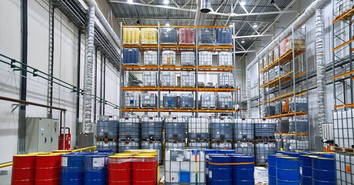Maintaining the quality of lubricants is a critical concern for plant managers, maintenance professionals, reliability engineers, and anyone involved in industrial operations. Poor storage can compromise lubricant integrity, leading to equipment damage, downtime, and increased costs. By implementing lubricant storage best practices to maintain quality, you can preserve lubricant performance and extend the life of critical machinery.
The Importance of Proper Lubricant Storage
Lubricants play a vital role in minimizing friction, reducing wear, and maintaining the smooth operation of machinery. However, even the best lubricants lose their effectiveness if stored improperly.
Contaminants like moisture, dirt, and air can seep into containers, breaking down the chemical composition and diminishing performance. Plant managers and maintenance teams must understand that protecting lubricants from these external factors is key to maintaining reliability and efficiency.
Temperature Control for Optimal Lubricant Quality
Temperature fluctuations can wreak havoc on the quality of lubricants. High temperatures accelerate oxidation, thickening the oil and reducing its effectiveness. On the other hand, extremely low temperatures can cause certain lubricants to solidify or lose fluidity, especially in colder climates.
The ideal storage environment is between 40 and 75 degrees Fahrenheit. Also, store lubricants away from heat sources like direct sunlight or industrial machinery. Keeping storage facilities temperature-controlled will protect your lubricants’ chemical makeup and viscosity.
Keep Lubricants in Their Original, Sealed Containers
One of the easiest ways to preserve lubricant integrity is by storing them in their original, sealed containers. Manufacturers design these containers to keep contaminants out and ensure long-term stability. While partially used containers may be unavoidable, reseal them tightly after each use. Always store containers upright to prevent spills and minimize the risk of contamination. When transferring lubricants to secondary containers, ensure they are clean, clearly labeled, and used solely for that specific lubricant.
Prevent Contamination With Clean Storage Practices
Choose a clean, dry location with low humidity to store lubricants. If proper precautions aren’t taken, dust, dirt, and debris in the storage area can quickly find their way into lubricant containers. Create a clear organizational system for your lubricants, separating different types and grades to avoid cross contamination. Additionally, regularly inspect containers for signs of damage, including cracks or leaks, which could allow contaminants to enter.
Regularly Rotate Lubricant Stock
Rotating your lubricant stock is essential for maintaining performance and ensuring that older products don’t expire. While many lubricants have a long shelf life, storage duration and conditions still impact their quality over time. Always use older stock first (first-in, first-out approach), checking expiration dates before use. Incorporating scheduled inspections for stored lubricants will help you identify deteriorated or expired products before they can harm equipment.
Proper lubricant storage practices preserve quality for smooth operations. Lubricant wholesale distributors like Santie Oil Company understand the importance of temperature control, contamination prevention, and structured inventory systems in protecting lubricants and the machinery they support. By educating your team on these best practices, you can reduce costly downtime and improve equipment reliability across your facility.

